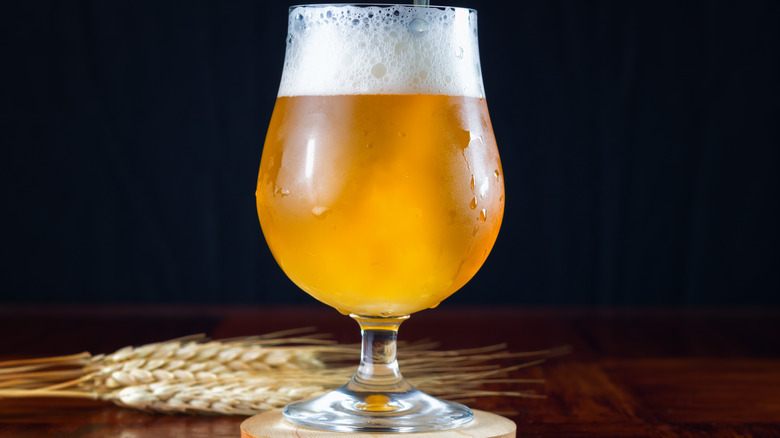Tulip Vs. Snifter Glass: Which Is Better For Beer?
If you're serious about your brews, it's time to get serious about your glassware. Whiskey drinkers already know that which whiskey glass you drink out of affects your experience, but the theory also applies to beer. According to Advanced Mixology, the quality of your beer is drastically affected by the glass you choose. The shape and rim of the glass can affect everything from how quickly your beer can go flat to how the beer smells.
So which glass should you be reaching for when pouring your next quaff? Spoiler alert: The common pint glass is popular at bars because it's easily stacked, not because it boosts the flavor of your beer. For the best pour, you need to broaden your horizons. You could try out the thistle glass, a floral cup often reserved for Scottish ales, or the tall and conical Pilsner glass, which was designed for, you guessed it, golden Pilsners. Even the slight hourglass shape of the Weizen glass could help you experience your wheat beer differently (via Homebrew Academy).
Perhaps the best place to start is with the tulip glass and the snifter. Increasingly popular with beer enthusiasts, they can be hard to tell apart, as they both have stems and wide bowls. This similar look can lead the beer layman into confusion. Which is better for beer?
The tulip glass traps aroma and is best for hoppy and malt beer
Named for its resemblance to the flower, the stemmed tulip glass has a bulbous bottom that narrows before opening into a delicately flared rim. According to Kegerator, this distinct glass design was made to trap the foam head of a freshly poured brew. The foam head contains much of the beer's aroma, offering a special preview for the senses before your first sip. Punch also notes that the stem helps keep the beer from warming up in your hand, much like a stemmed wineglass protects your Sauvignon blanc's chill.
Thanks to its scent-enhancing design, the tulip glass amplifies the flavor of beers with intense aromas, like malt and hops (via Shore Craft Beer). A hoppy beer denotes a pleasantly bitter-tasting brew, like double IPAs and other pale ales that use plenty of hops to make their beer. According to Rolling Hops, malty beers describe a toasted or smokey flavor often found in barley wines, stouts, and porters. Also known as Belgian glass, the tulip glass will work for many Belgian classics, from saisons to Flemish reds.
The snifter glass allows swirling and is best for beers with high ABV
Described as a diminutive version of the tulip glass by Punch, the snifter glass has a large bowl base that gently tapers at the rim. More commonly associated with the world of brandy and cognac, this wide-bowl design encourages the taster to swirl their drink, as it stirs up the aromatics and forces them to the top. Kegerator suggests this method works just as well for beers, although one should be careful not to overfill their glass to avoid a sudsy eruption.
Like the tulip glass, the snifter is about bringing the beer's sophisticated aroma to the nose before the first sip, so it naturally works well with the same strong-scented brews. Kegerator suggests that tulip and snifter glasses can be excellent options for the hoppy double and Imperial IPAs, with the caveat that drinkers must fill the snifter glass with less so that they can accommodate gentle swirling.
Punch takes it further, recommending the snifter for beers with a high ABV (alcohol by volume). Why? The snifter encourages the drinker to sip rather than gulp, and beer with a high ABV will still satisfy this slow-sipping style. So if you find yourself with a bottle of Snake Venom, the world's strongest beer, your glass of choice should be a small snifter.
All told, one glass isn't better than the other for beer. But if you're going to sip on a brew that's a bit stronger and aromatic, you'll want one of these two on hand to fully enjoy it.


